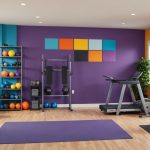Creative Space Planning for Toddler Play Areas
Designing a toddler play area in a small apartment requires creativity and efficient space optimization. One effective method is to utilize vertical space. Shelving and wall-mounted toys not only keep the floor clear for play but also offer ample storage. Select sturdy shelves and ensure they are securely attached to the wall for safety.
Arranging furniture strategically can create open zones for play while maintaining a safe environment. Position larger pieces, like couches or cabinets, to form natural boundaries, which help define and contain play areas. This can help manage toys and activities, making them more accessible for toddlers while maintaining a tidy space.
Also to discover : Create Your Ultimate Creative Sanctuary: Designing the Perfect Craft Room for Scrapbooking and Fabric Arts
Clearly defined boundaries in shared family spaces are essential. Utilize rugs of different textures or colours to visually distinguish the toddler play area from the rest of the living space. You can also use child-friendly gates or low bookshelves to create these separations. This design approach ensures that playtime doesn’t overtake the entire apartment, and helps children understand where play is encouraged.
Effective use of small apartment play spaces involves balancing an open, inviting area with safety features and practical functionality, enabling toddlers to explore and enjoy their environment thoroughly.
Also read : Transform Your Home Gym: Crafting a Vibrant Color Palette to Enhance Focus and Energy
Safety First: Essential Items for a Toddler Play Area
Creating a safe play environment is paramount when designing a toddler play area. Child safety products like outlet covers and corner guards are crucial to prevent accidents. These simple tools ensure that curious fingers are kept safe from electrical hazards and sharp edges. Additionally, it’s wise to invest in non-toxic materials for toys and play equipment. This choice ensures that items your child might chew on or handle frequently do not pose chemical risks.
Supervision is another key component of safety in a multi-use space. Even with the best safety measures, the watchful eye of a caregiver is irreplaceable. Conducting regular risk assessments can help identify potential dangers as your toddler grows and explores new skills.
Incorporating supervision with safety tools like gates can create a toddler-proof environment. Barrier gates serve dual purposes—they not only keep toddlers safe from off-limit zones but also define their play areas. This approach combines both safety and spatial definition, providing peace of mind and room for creativity. Remember, integrating security with functional design supports a well-rounded and safe play space, fostering both exploration and protection.
Multi-Functional Furniture Solutions
Selecting space-saving furniture is key in creating an efficient toddler play area design. Opt for dual-purpose furniture that ensures practical use without sacrificing the comfort of your small apartment. For instance, storage benches and ottomans are excellent, as they hide toys while providing seating space. These pieces cleverly combine storage with lounging, keeping the play area tidy yet welcoming.
Introducing collapsible items offers versatility and adaptability. Foldable play tables or stackable chairs can be effortlessly stored when not in use, freeing up room for play activities. Choose furniture that can transition seamlessly between different functions to accommodate both the whims of toddlers and the demands of everyday living.
When considering toddler-friendly storage, focus on features that make tidying easy and enjoyable. Lower shelves or units with reachable compartments empower toddlers to access toys independently, fostering responsibility and independence. Furniture choices in toddler play areas should blend seamlessly into daily routines, promoting playtime without overwhelming the space.
Investing in furniture designed for flexibility and function ensures a harmonious balance between practicality and play, making the most of limited areas and encouraging active exploration. Prioritize designs that maximize space and invite children to interact with their environment creatively.
Engaging Activities and Play Ideas
Toddlers thrive with interactive play, especially in small apartment play spaces where creativity meets practicality. Integrating toddler play activities like sensory bins and art stations offers low-footprint solutions. These activities require minimal setup, using compact, contained spaces that fit well in limited environments. Sensory bins engage toddlers with textures and colours, stimulating their tactile senses. Meanwhile, a compact art station encourages creativity without devouring space.
Household items can serve as creative play solutions, transforming everyday routines into enriching experiences. Pots and pans become percussion instruments; an empty box evolves into a mystical cave. Repurposing items not only fuels imagination but also emphasizes sustainable use of available resources. Introducing learning games through commonplace objects can effectively enhance cognitive and motor skills.
To maintain high engagement, it’s crucial to rotate toys and activities regularly. By rotating resources, toddlers encounter new stimuli, preventing boredom and encouraging continued exploration. This method also streamlines cleaning efforts, as fewer items are available at any point, promoting tidiness.
Select play ideas that align with your child’s interests and apartment layout, ensuring that each toddler play area design supports both learning and exploration in a comfortable space. Rotate and refresh with intention to keep the excitement alive.
Storage Solutions for Play Items
When living with limited space, effective organization tips are essential for maintaining a tidy toddler play area design. Begin by exploring innovative toy storage options. Under-bed storage is a clever way to maximize space. Low-profile bins or drawers can slide easily beneath furniture, providing discreet yet accessible storage for toys.
Wall organizers are another fantastic solution, ideal for creating vertical storage without compromising floor space. Shelves or hanging pockets can hold various items, allowing easy visibility and reach. This approach helps keep the play area tidy, promoting a clutter-free environment.
Using labeled containers such as bins and baskets enhances organisation. Labels aid toddlers in identifying where each toy belongs, fostering a sense of responsibility and independence. Clear labeling simplifies cleanup routines, transforming tidying into an engaging activity.
For decluttering, regular assessment is key. Periodically remove toys no longer in use to maintain an uncluttered space. Rotate select toys back into circulation over time to sustain interest and manage space effectively.
Integrating these maximizing space methods within a small apartment helps uphold an inviting and functional play environment. Systems tailored to your needs ensure that every corner of your play area remains purposeful and well-organized.
Visual Inspiration and Real-Life Examples
Imagining a unique toddler room inspiration is essential for an effective design in small spaces. One successful approach is to review play area case studies that showcase innovative solutions. Real-life examples offer valuable insights into overcoming space restrictions, showing creative use of colors and furniture. They highlight what can be achieved with clever space planning and smart design.
Design testimonials from parents further illustrate these successes. Many share their triumphs in balancing functionality and aesthetics, emphasising the practical tips they adopted. These testimonials often highlight the importance of understanding both the spatial dynamics and the needs of toddlers, providing a relatable source of advice for others in similar situations.
Exploring current design trends can enhance these insights, especially trends prioritising safety and engagement. For instance, modern trends focus on creating playful environments that remain safe without restricting a child’s movement. This might involve using soft, colourful mats that double as creative play surfaces, essentially combining style with safety concerns.
To replicate these inspiring designs, focus on how other parents adapted their spaces. Take inspiration from their choices, utilise small apartment layouts effectively, and create a vibrant, safe, and enjoyable space that stimulates your child’s growth and creativity.





